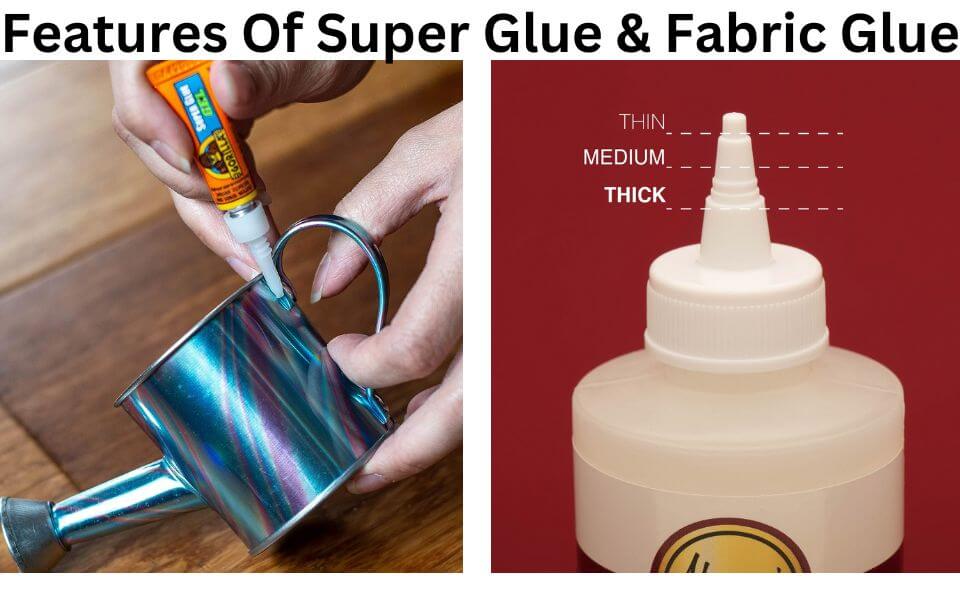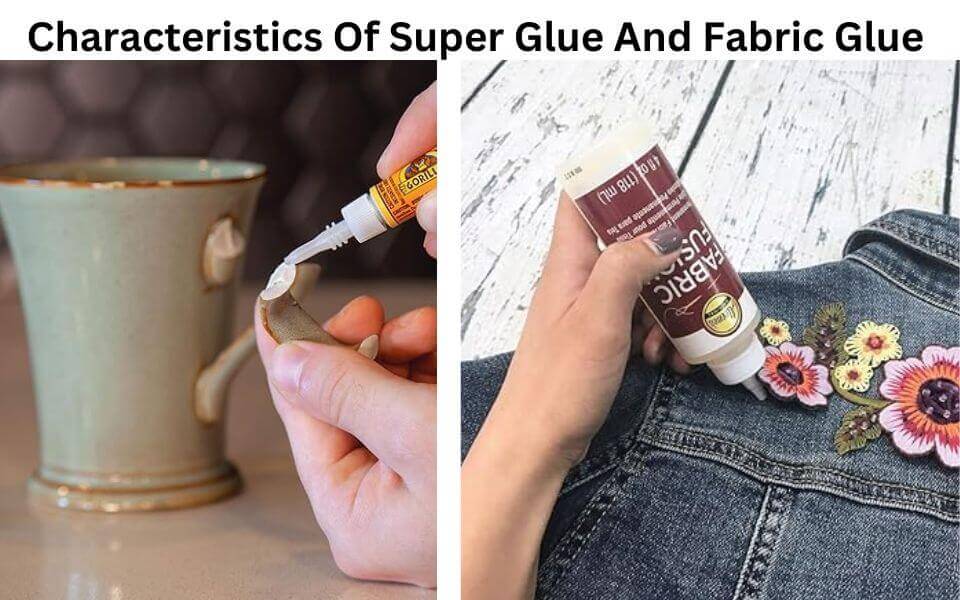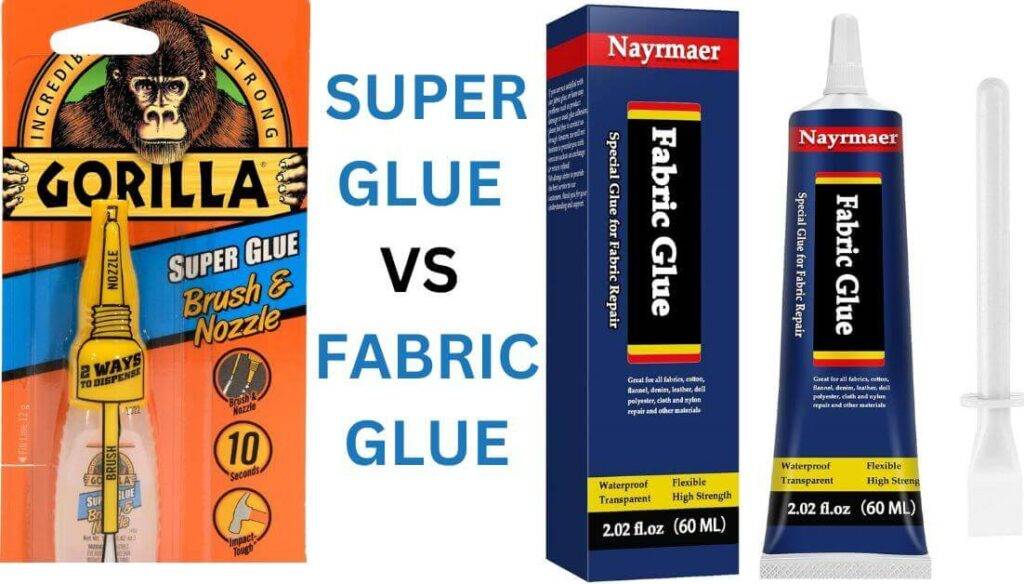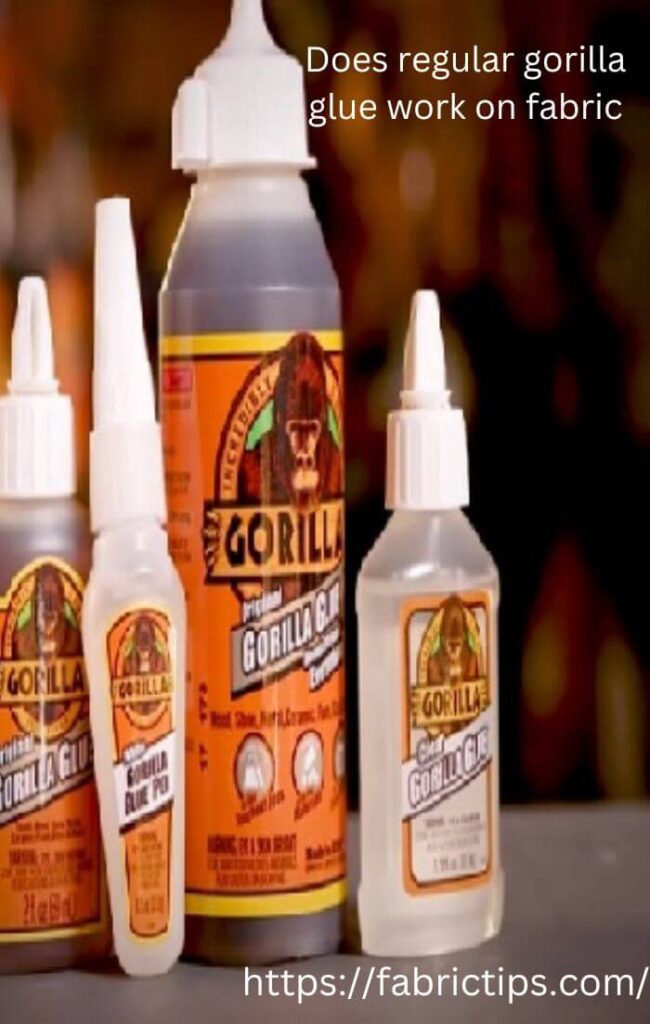Last Updated on November 20, 2023 by Wahid
When it comes to choosing between super glue and fabric glue, the decision should always be guided by the specific needs of the project at hand. Final thoughts & recommendations for users considering the “Super Glue Vs Fabric Glue” conundrum:
- Assess the Material: Always consider the materials you are working with. Super glue is unparalleled for quick fixes on non-porous materials, while fabric glue is essential for textile projects.
- Consider Flexibility Needs: If the repair or project requires the material to remain flexible, fabric glue is the recommended choice.
- Durability & Usage: For items that will undergo stress or need to withstand various conditions, choose the glue that provides the appropriate level of durability for the use case.
- Safety & Toxicity: Consider the environment in which the glued object will be used. If it’s for something like children’s toys or wearables, look for non-toxic, skin-safe options.
Recommendations:
- For Home Repairs: Keep a bottle of super glue on hand for a variety of quick home repairs.
- For Crafters & Textile Work: Stock fabric glue in your crafting kit, especially if you work with yarn, cloth, or other flexible materials.
- Read Instructions Carefully: Regardless of the glue chosen, always read and follow the manufacturer’s instructions for the best results.
- Test First: If possible, test the glue on a small, inconspicuous area of the material to ensure compatibility.
- Safety Precautions: Use both types of glue in well-ventilated areas and wear protective gear if necessary.
Ultimately, there isn’t a one-size-fits-all answer in the “Super Glue Vs Fabric Glue” debate. Whether you’re a DIY enthusiast, a professional repair person, or a hobbyist crafter, having both types of glue in your toolkit will prepare you for a wide array of challenges.
What is Super Glue?
“Super Glue”, known for its incredible strength and quick bonding time, is the common name for cyanoacrylate adhesives. These powerful glues are renowned for creating strong, lasting bonds within seconds and are ideal for small-scale repairs that require a firm hold. Super glue works best on non-porous surfaces such as metal, plastic, and glass, making it a versatile choice for various household and industrial applications.
Yes, its efficacy comes from its ability to react with moisture on the surface of the materials being bonded, creating a tight molecular chain that is notoriously difficult to break. When weighing “Super Glue Vs Fabric Glue,” it’s essential to recognize that super glue’s rigid hold makes it less suitable for materials that need to retain flexibility, such as fabrics.
What is Fabric Glue?
“Fabric Glue”, on the other hand, is specifically formulated for bonding textiles. This type of adhesive is tailored to the needs of the fabric, ensuring that the bond remains flexible even after drying, which is crucial for clothing, upholstery, and other fabric crafts.
Unlike super glue, fabric glue seeps into the fibers, creating a strong bond that can often withstand washing and wear and tear. It’s the perfect solution for hemming, quilting, and attaching decorative elements to garments without sewing. In the “Super Glue Vs Fabric Glue” debate, fabric glue stands out for its specialized application in textile work, where it surpasses super glue by maintaining the integrity and suppleness of the fabric.
By understanding the distinctive qualities and optimal uses of each adhesive, users can make informed decisions for their projects. Whether opting for the robust fixity of super glue in rigid repairs or the durable flexibility of fabric glue in textile applications, selecting the right glue is paramount to project success.
See Other Post: Fabric Glue Vs Sewing: Who Is Winner & Why?
Comparison Table: Super Glue Vs Fabric Glue

When considering “Super Glue Vs Fabric Glue,” it’s crucial to factor in the specific requirements of your project. Super glue, owing to its cyanoacrylate base, excels in creating high-strength bonds on non-porous materials, making it indispensable for quick and permanent fixes. Fabric glue, tailored to the needs of flexible and porous materials, provides a durable yet flexible bond, essential for textile work.
| Feature | Super Glue | Fabric Glue |
| Primary Ingredient: | Cyanoacrylate | Various (including PVA or Polyvinyl Acetate) |
| Suitable Materials: | Non-porous surfaces like metal, plastic, and glass | Porous materials like cotton, linen, and synthetics |
| Bonding Time: | Sets in seconds to minutes | Varies; some set quickly, others require drying time |
| Durability: | Extremely strong, designed for permanent repairs | Flexible; withstands bending and movement |
| Flexibility After Drying: | Rigid | Maintains flexibility with the fabric |
| Water Resistance: | High; most super glues are waterproof | Varies; some are water-resistant, others are not |
| Heat Resistance: | Generally high | Typically lower compared to super glue |
| Usability: | Easy to use for quick repairs | Requires a more careful application |
| Curing Time: | Quick curing | Longer curing, especially on thick fabric layers |
| Color Once Dry: | Clear | Usually clear, some may dry opaque |
| Ease of Use: | Very easy to apply with precision | May require spreading or the use of an applicator |
| Odor: | Strong, pungent odor | Milder odor compared to super glue |
| Versatility: | High for non-flexible materials | High for textiles and flexible materials |
| Typical Applications: | Quick repairs, small crafts, household fixes | Textile repairs, fabric crafts, hemming without sewing |
| Ease of Removal: | Difficult, often requires acetone or debonder | Easier, can often be washed out if water-soluble |
This comparison table highlights the stark contrasts between the two, integrating key terms such as “bonding time,” “durability,” and “flexibility” to assist you in making an informed choice between these adhesive options.
Detailed Features Of Super Glue & Fabric Glue

When delving into the detailed features of adhesives, particularly in the “Super Glue Vs Fabric Glue” comparison, several key attributes must be evaluated to determine their suitability for various applications.
Bonding Time
Super Glue:
- Sets incredibly fast, often in a matter of seconds.
- Full curing can take up to 24 hours for maximum bond strength, but handling strength is achieved almost immediately.
- Ideal for quick repairs where time is of the essence.
Fabric Glue:
- Varies between instant bond to needing several minutes or hours to set.
- Longer drying time allows for repositioning and adjustments before the glue fully sets.
- Full curing could take anywhere from several hours to a full day, depending on the glue formulation and fabric thickness.
Durability
Super Glue:
- Known for its high tensile strength, providing a permanent bond that is difficult to break.
- Can become brittle over time, especially under varying temperatures and loads.
- Less effective on surfaces that flex, as the rigid bond can crack.
Fabric Glue:
- Offers a durable bond that can flex with the fabric, maintaining its hold through wear and tear.
- Often formulated to withstand washing and dry cleaning, essential for clothing and upholstery.
- Longevity is influenced by the type of fabric and frequency of laundering.
Flexibility
Super Glue:
- Once cured, it forms a rigid bond, which lacks flexibility.
- Not ideal for materials that need to maintain movement or flexibility.
Fabric Glue:
- Remains flexible after drying, moving with the fabric and preventing stiffness.
- Essential for textiles that are regularly moved or folded, maintaining the comfort and functionality of the fabric.
Water Resistance
Super Glue:
- Typically offers excellent water resistance, making it suitable for items that are exposed to moisture.
- Not all superglues are equal, though; some specialized types can fully withstand submersion after curing.
Fabric Glue:
- Water resistance can vary greatly among fabric glues.
- Some are designed to be fully washable and can be used on clothing and outdoor fabrics, while others might weaken when wet.
In summary, the decision between “Super Glue Vs Fabric Glue” hinges on the needs of the project at hand. When a rigid, waterproof, and durable bond is required, super glue is often the adhesive of choice. For projects that demand a strong yet flexible bond that can endure the rigors of washing and daily use, fabric glue is more appropriate.
Benefits Of Using The Correct Glue
The benefits of choosing the right glue for the task at hand cannot be overstated. Whether it’s a quick fix or a detailed craft project, using the correct adhesive is essential for achieving the best results. Here’s how selecting the appropriate glue can make a difference, keeping in mind the “Fabric Glue Vs Super Glue” debate:
Optimal Bond Strength:
The right glue ensures that the bond formed is as strong as necessary for the materials involved. For instance, super glue creates a super-strong, durable bond perfect for hard, non-porous materials, while fabric glue is designed to withstand the flexible and porous nature of textiles.
Durability & Longevity:
Using the correct adhesive means your repair or project will last longer. Fabric glue, for example, provides a flexible bond that moves with the fabric, making it ideal for wearable and frequently used items, unlike super glue, which could crack under constant movement or strain.
Ease of Application:
Each glue is formulated with a specific application process in mind. Super glue is typically in a gel or liquid form that can be precisely applied, while fabric glue may come with applicators suited for porous surfaces, allowing for even distribution over a large area.
Resistance to Elements:
Certain projects require resistance to elements such as water, heat, or cold. Super glue often offers excellent resistance to water and temperature changes, making it great for items that may be exposed to harsh conditions. Conversely, fabric glues are sometimes washable and can be safely cleaned without compromising the bond.
Flexibility:
When working with materials that need to retain their flexibility, like fabrics, using a specialized fabric glue ensures that the end product remains pliable and comfortable. This is something that super glue cannot guarantee due to its rigid nature once cured.
Aesthetic Finish:
The right glue won’t only hold your materials together; it will also maintain the look you want. Fabric glues dry clear and remain undetectable within the weave of most fabrics, preserving the original appearance and feel of the material.
Safety & Comfort:
Certain glues are better for items that come into contact with skin or that need to be non-toxic once cured. Fabric glue often meets these requirements, being designed specifically for clothing and wearable items, while super glue is better kept for non-flexible surfaces and non-wearable crafts.
Incorporating these benefits into your decision-making process with a clear understanding of when to use Super Glue vs. fabric Glue is key. Using the correct glue not only improves the performance and durability of your projects but also ensures safety, efficiency, and aesthetic integrity.
See Other Post: Gorilla Glue Gel Vs Regular: Comparison & Winner?
Characteristics Of Super Glue And Fabric Glue

When discussing the characteristics of “Super Glue Vs Fabric Glue,” it’s important to dive into the inherent properties that define their performance in various scenarios. Both have unique attributes that make them well-suited for particular materials and applications.
Characteristics Of Super Glue:
1. Composition: Super glue is predominantly made up of cyanoacrylate. Which is an acrylic resin that rapidly polymerizes in the presence of water (humidity), adhering tightly to most surfaces.
2. Bonding Ability: It has a remarkable ability to bond strongly and quickly to non-porous surfaces, creating a very strong bond that is typically resistant to shear forces.
3. Curing Speed: Super glue sets and cures extremely quickly, often in seconds, which is a significant advantage when time is a factor.
4. Temperature & Chemical Resistance: High-quality super glue can withstand extreme temperatures and is resistant to chemicals and solvents once fully cured.
5. Rigidity: Upon curing, super glue becomes rigid, making it unsuitable for materials that require flexibility.
6. Versatility: While it is versatile in terms of the range of materials it can bond, its rigid nature limits its application in situations where movement or bending is involved.
7. Ease of Use: It’s easy to apply, typically coming in small tubes that are ideal for precise application.
Characteristics Of Fabric Glue:
1. Composition: Fabric glue can be made from a variety of substances, including polyvinyl acetate (PVA), polyurethane, or other synthetic polymers that are designed to be flexible and durable.
2. Bonding Ability: Designed specifically for porous materials, it seeps into the fibers of fabric to create a bond that can flex with the material, making it ideal for clothing and upholstery.
3. Curing Speed: The drying time for fabric glue can vary, with some requiring a longer time to set compared to super glue, offering a window for repositioning if necessary.
4. Washability: A key characteristic is its resistance to water once cured, with many fabric glues able to withstand regular washing cycles.
5. Flexibility: Maintains the fabric’s flexibility, which is crucial for comfortable wear and natural movement of textiles.
6. Specialized Use: While less versatile in the range of materials, fabric glue is specifically tailored for textile projects, outperforming super glue in this domain.
7. Application Techniques: It may require different application methods such as spreading with a brush or an applicator, making it slightly less straightforward to use than super glue.
In the comparison of “Super Glue Vs Fabric Glue,” it’s evident that each has been developed with distinct characteristics tailored to their intended use cases. Super glue’s rapid bonding and strong hold are counterbalanced by fabric glue’s flexibility and fabric-friendly formulation. These characteristics should guide users in choosing the right glue for their needs, ensuring a successful outcome for their projects.
Common Uses for Super Glue and Fabric Glue
When evaluating “Super Glue Vs Fabric Glue,” it’s helpful to understand their common uses. Each type of glue is tailored to specific applications based on its unique properties. Below are the typical uses for both super glue and fabric glue, integrating relevant keywords to enhance understanding and discoverability.
Common Uses For Super Glue:
1. Quick Repairs: Super glue is a go-to for rapid repair of non-porous materials like plastic, metal, glass, and ceramics.
2. Woodworking: It’s used in woodworking for joining small pieces and for repairing cracks or chips in wooden objects.
3. DIY Crafts: Craft enthusiasts often use super glue for creating models, assembling intricate parts, and jewelry making due to its strong bond and quick set time.
4. Home Fixtures: It is suitable for small household repairs, such as fixing a broken vase or a detached sole of a shoe.
5. Automotive Repairs: In the automotive sector, super glue can be used for minor fixes such as repairing a broken tail light casing or reattaching trim pieces.
Common Uses For Fabric Glue:
1. Textile Repairs: Fabric glue is commonly used for mending tears, hemming, and applying patches without sewing.
2. Embellishments: It’s perfect for adhering decorative elements like sequins, beads, and lace to garments and textile projects.
3. Upholstery: Fabric glue is used in upholstery to attach fabric to furniture, fix loose threads, and repair upholstered surfaces.
4. Crafting: For crafting enthusiasts, fabric glue is ideal for creating fabric-based projects such as scrapbooking, costume design, and felt crafts.
5. Wearable Art: It’s also used for creating wearable art, as it allows for flexibility and is often washable, ensuring the longevity of the art piece.
When considering the “Super Glue Vs Fabric Glue” debate, recognizing the appropriate context for each type of adhesive is crucial. Super glue’s rapid adhesion capabilities make it an excellent choice for fast, durable repairs on hard surfaces, while fabric glue’s flexibility and compatibility with textiles make it indispensable for fabric crafts and repairs. Understanding their common uses ensures that the right glue is selected for the job, leading to optimal results and satisfaction in both crafting and repair work.
Super Glue Vs Fabric Glue: Who Wins The Battle?
In the battle of “Super Glue Vs Fabric Glue,” declaring a winner isn’t about one being superior to the other; it’s about which glue is best suited for a particular application. Both adhesives have their unique strengths and ideal use cases, so the victor depends on the task at hand. Here’s how they fare in various scenarios:
For Quick Repairs & Strong Bonds:
Super Glue is the Winner
- For non-porous materials needing an immediate and robust bond, super glue excels.
- It’s the go-to for emergency fixes, from a broken pair of glasses to a detached shoe heel.
For Flexibility & Fabric Applications:
Fabric Glue Takes the Crown
- When working with textiles, fabric glue is unmatched due to its ability to flex and withstand repeated washing.
- It’s the best option for repairs and creations that require maintaining the fabric’s natural movement and texture.
In Terms Of Versatility Across Various Materials:
Super Glue Stands Out
- Its ability to adhere to a wide array of materials from wood to plastic to ceramic makes it more versatile for general household use.
- Super glue is often a staple in toolkits for its multi-material applications.
When Considering Specialized Textile Work:
Fabric Glue is a Clear Choice
- From costume design to quilt making, fabric glue’s specialized formula is designed to handle the nuances of different textiles.
- Its washability and durability on fabrics make it indispensable in sewing and crafting circles.
For Overall Durability:
It’s a Tie Depending on Conditions
- Super glue offers a strong, durable bond for hard goods that do not require movement.
- Fabric glue provides a resilient bond that can move with fabric and endure wash cycles.
To summarize, the “winner” between super glue and fabric glue is context-dependent. Each adhesive serves a specific purpose, and the optimal choice will align with the demands of the material and the performance required. For the strongest bond in non-flexible situations, super glue’s rapid adhesion and strong hold are unparalleled. In contrast, for textile projects and applications where flexibility is non-negotiable, fabric glue is essential.
FAQs
Q-1: Can I use super glue instead of fabric glue for a quick clothing repair?
Answer: While super glue can temporarily fix a piece of clothing, it’s not the best choice due to its rigid nature after drying. Fabric glue is specifically formulated to remain flexible and withstand washing, making it the superior option for clothing repairs.
Q-2: Will fabric glue hold as strongly as super glue on materials like wood or plastic?
Answer: Fabric glue is designed for textiles and may not provide a bond as strong as super glue on non-porous materials like wood or plastic. For those, super glue is typically the better adhesive due to its powerful bonding ability on non-textile surfaces.
Q-3: Can super glue be used on any type of fabric?
Answer: It’s not recommended to use super glue on fabrics because it can cause the material to become stiff and may not hold up to washing and wear. Fabric glue should be used for a bond that needs to maintain flexibility and softness.
Q-4: Is fabric glue durable enough for heavy-duty applications, like outdoor gear repairs?
Answer: Yes, certain types of fabric glue are made for heavy-duty applications and can be very durable, even on outdoor gear. It’s important to choose a fabric glue that specifies heavy-duty use for the best results.
Q-5: How do I remove super glue if I accidentally apply it to fabric?
Answer: Removing super glue from fabric can be challenging. Acetone (found in many nail polish removers) can dissolve super glue, but it may also damage or discolor the fabric. It’s advisable to test a small, inconspicuous area first or consult a professional.
Q-6: Are there any non-toxic alternatives to super glue that can be used on items like children’s toys?
Answer: Yes, there are non-toxic adhesives available that are safe for use on children’s toys. Look for products that are specifically labeled as non-toxic. Fabric glue may be an option for plush toys, but for hard toys, search for a non-toxic super glue alternative.
Q-7: What’s the best way to apply fabric glue to ensure it holds?
Answer: To ensure a strong bond with fabric glue, apply it evenly across the surface, press the pieces together firmly, and allow it to cure for the time specified by the manufacturer. Make sure the fabric is clean and dry before application.
Q-8: Does super glue dry clear, or will it leave a residue on surfaces like glass or metal?
Answer: Most super glues dry clear, making them a suitable option for materials like glass and metal where residue might be visible. However, some might still leave a glossy finish, so it’s best to check the specific product details.
Q-9: Are there any fabric glues that dry quickly like super glue for last-minute fixes?
Answer: There are fast-setting fabric glues available that dry quicker than traditional fabric adhesives, though they may not set as instantly as super glue. Check the packaging for drying times to find a quick-dry option.
Q-10: For crafting, when should I choose fabric glue over super glue?
Answer: Choose fabric glue over super glue for crafting when working with flexible or porous materials like fabric, felt, or lace. For non-porous materials like plastics, metals, or wood, superglue is often more appropriate.
Final Thoughts
Adhesives play a pivotal role in both DIY projects and professional applications. Among the plethora of options, super glue and fabric glue are often the go-to choices for their respective strengths and specialized uses. Understanding the nuanced differences between the two can be crucial for your project’s success.
However, this comprehensive guide will delve into the specifics of Super Glue Vs Fabric Glue, providing you with the knowledge to choose the right adhesive for your needs.




